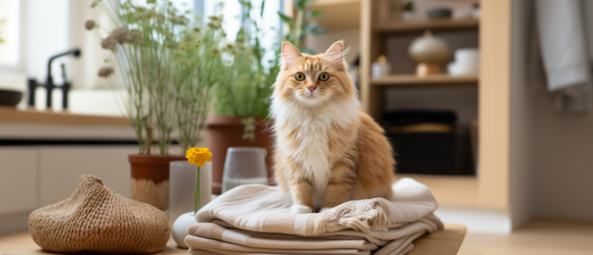Keyword:New home;New cat
What should I do for introduce my cat to it’s new home Here are the steps:
Create cat-safety zone for them; Familiar scents can make them relax much easier; Let them adapt gradually: Maintaining consistent as usual: Building Positive Associations: Patience and Observation:

Intro: Moving to a new home can be an exciting adventure, but it can also be a stressful experience for our feline friends. Cats are creatures of habit and can be sensitive to changes in their environment. To help your cat adjust smoothly and feel at ease in their new surroundings, we've crafted a step-by-step guide to introducing your cat to a new home. By following these simple strategies, you can create a welcoming environment and ensure a seamless transition for your beloved feline companion.
Prepare in advance: Before your cat's arrival, it's crucial to prepare the new home to ensure their safety and well-being. Here are some tips for creating cat-safety zone: Remove all potential hazards or toxic substances that could harm your cat. Secure loose wires, cover electrical outlets, and ensure windows and balconies are safely enclosed. suffocate or experience intestinal blockages due to curiosity or ingesting plastic bags or plastic wrap. Open windows and balconies: Cats may attempt to jump out of open windows or balconies, which can result in serious injuries or accidents. Ensure that windows and balconies have appropriate safety measures to prevent cats from jumping out.

What are the potentially dangerous for cat?
Toxic substances: Many common foods and items for humans are toxic to cats, such as chocolate, coffee, alcohol, onions, garlic, grapes, medications (including over the counter and prescription drugs), and more. Ensure that these items are kept out of the reach of cats. Household cleaning products: Certain chemicals in household cleaning products can be harmful to cats. Be careful when using these products and ensure that cats cannot encounter, lick, or inhale harmful substances. Plants: Some indoor and outdoor plants are toxic to cats, such as lilies, peace lilies, ivy, daffodils, and more. Small objects: small toys, coins, thumbtacks, glue, strings, tapes, and other small objects can be swallowed by cats, leading to choking, intestinal blockages, or other digestive issues. Make sure to store these items properly. Plastic bags and plastic wrap: Cats may suffocate or experience intestinal blockages due to curiosity or ingesting plastic bags or plastic wrap. Open windows and balconies: Cats may attempt to jump out of open windows or balconies, which can result in serious injuries or accidents. Ensure that windows and balconies have appropriate safety measures to prevent cats from jumping out.

Maintaining consistent as usual: Highlight the importance of maintaining a consistent routine during the transition period.
Designated Areas for Essential Resources: Create designated areas for food, water, litter boxes, and resting spots. Cats appreciate having their own spaces for these resources, which helps them feel secure and in control. How to choose a food area for your cat? Cats like to eat in quiet and private areas. Set up a quiet corner as their dining area, away from noisy and busy areas. Some cats may prefer to eat in a location that is separate from their litter box.
How to get cats used to drinking in a fixed place?
Cats prefer to drink near clean and fresh water sources. Provide a clean water bowl and ensure that the water is always fresh.

How to choose a place where cats are used to rest?
Cats enjoy resting in warm, soft, and comfortable places. They may choose cushions, beds, sofas, nests, or cat trees. Provide a comfortable cat bed or mat placed in a quiet corner for the cat to rest.

How to get your cat used to using the litter box?
Ensure that the cat litter box is clean, without any odor, and clean the litter regularly. Cats are very particular about hygiene, and they may not be willing to use a litter box that is dirty or has an unpleasant smell. If you have multiple cats, make sure to provide an adequate number of litter boxes. Each cat should have its own litter box, and having additional litter boxes can reduce competition and urinary issues. Choose a quiet, secluded, and easily accessible location to place the litter box, away from noisy areas and the cat's feeding area. Cats prefer to use the litter box in a place that offers privacy and a sense of security.

What if my cat or kitten don’t use the litter box?
If you have a kitten or a newly adopted cat, help them establish a positive association with the litter box. Observe the cat's behavior before they use the litter box, and if they show signs of seeking a suitable place (such as squatting or scratching the ground), gently guide them to the litter box so they can experience the correct location. When the cat uses the litter box, provide positive praise and rewards such as verbal praise, gentle petting, or small treats. Positive reinforcement helps build a positive association and habit with the litter box.

Familiarizing Your Cat with Their Scent: Familiar scents can greatly reduce stress for your cat, as they provide a sense of familiarity and comfort. Consider the following: Familiar Bedding or Items: Use bedding or items from your cat's previous home that carry their scent. This can be placed in their new living space to provide a familiar scent and ease their adjustment. Gradual Introductions.
Why scent can let my cat calm?
Cats have scent glands on various parts of their bodies, and they use scent marking as a way to communicate and establish their territory. Cats are creatures of habit and routine. Cats associate familiar scents with safety and security. Smells that they recognize, such as the scent of their owner or the scent of their own territory, signal a familiar and comfortable environment. This familiarity can help reduce stress and anxiety, promoting a sense of relaxation.

How can I build positive associations?
Introduce scents that are familiar to your cat, such as your own scent or the scent of other household members. You can do this by gently rubbing a soft cloth or towel on yourself or the desired person and then placing it in areas where your cat spends time or rests. If you have other pets in the household, you can swap scents between them. Rub a cloth or towel on one pet and then place it near the other pet's resting area. This helps familiarize the scents and create a sense of comfort and familiarity. If you want to introduce new scents, such as new furniture, blankets, or toys, do it gradually. Allow your cat to approach and investigate the new items at their own pace. You can also rub these items with a cloth that has your cat's scent on it to help associate the new scent with familiarity. Ensure that your cat has a comfortable and familiar space where they can retreat and relax. This can include their favorite blanket, bed, or hiding spots. Consistency in their environment helps create a sense of security.

Anything else can calm our cat?
Certain scents, such as lavender or chamomile, are known to have a calming effect on cats.

Let them adapt gradually: Gradual introductions to different areas of the new home are crucial for your cat's comfort. Follow these steps: Start with a Small Space: Begin by confining your cat to a single room with all their essential resources. This allows them to acclimate to their new environment in a controlled and safe space. Expand Access Gradually: Once your cat becomes comfortable in the initial room, gradually open up access to other areas of the house. This gradual process helps them adjust to new sights, sounds, and smells at their own pace.

Building Positive Associations and observe patiently Explain the concept of positive reinforcement in creating a positive association with the new home. Discuss the use of treats, toys, and praise to reward your cat for exploring and interacting with their new environment. Provide suggestions for interactive play sessions to bond with your cat and help them feel secure. Stress the importance of patience during the adjustment period. Encourage cat owners to observe their cat's behavior and body language for signs of stress or discomfort. Provide guidance on when to seek professional help if your cat exhibits prolonged signs of anxiety or refuses to adjust.

Conclusion: Introducing your cat to a new home is a process that requires patience, understanding, and careful planning. By following this step-by-step guide, you can help your feline friend settle in comfortably and adapt to their new surroundings. Remember, each cat is unique, so it's essential to tailor the approach to your cat's personality and needs. With your love, support, and a little extra effort, you can create a welcoming haven where your cat can thrive in their new home.




Leave a comment
All comments are moderated before being published.
This site is protected by reCAPTCHA and the Google Privacy Policy and Terms of Service apply.